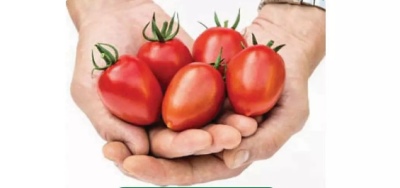
- Authors: Blokin-Mechtalin V.I.
- Year of approval: 2019
- Name synonyms: Cherryvala
- Category: hybrid
- Growth type: indeterminate
- Appointment: fresh consumption
- Ripening period: early
- Ripening time, days: 95
- Growing conditions: for film greenhouses, for greenhouses
- Transportability: high
Tomato Cherry Valya, or Cherryvala, is the author's variety of V.I. Blokin-Mechtalin, in whose arsenal there are already many modern, productive varieties of vegetables with a twist. Included in the State Register of Varieties of the Russian Federation in 2019.
Description of the variety
Indeterminate hybrid, up to 2 meters tall, The foliage is long, dark green, large, with a small stitch, abundant. The first inflorescences are laid over the 9th leaf, the subsequent ones - every 2-3 leaves.
The main qualities of the fruit
This is a cherry tomato, with small, up to 45 grams, oval fruits of a very rich red color. If you look closely, the fruit shows weak ribs. Pointed tip. There are 8-20 fruits in 1 bunch. Racemes are simple or semi-complex, beautiful, with optimal length petioles. The stalks are neat, the fruits are even, calibrated, perfectly separated from the stalks. The seed chambers are noticeable, the walls are thick and juicy. The pulp is fleshy, the skin is dense, thin, with shine. Ripe fruits really resemble cherries: they are just as bright and shiny.
Taste characteristics
The variety is sweet, with a sweet, bright and rich taste. Contains an increased amount of lycopene, a substance that reduces the amount of bad cholesterol and improves blood quality. The main purpose is fresh consumption: sandwiches, salads, snacks, drinks. But, thanks to their size and lycopene, which is most in processed tomatoes, Cherry Valya tomatoes are ideal in whole-fruit harvests. Surplus crops can be used to make tomato juice, sauce, pasta, and ketchup.
Ripening and fruiting
Ripening early, you can remove the fruits after 95 days. The variety is distinguished by a very amicable ripening, you do not need to pick the first fruits and wait until the rest ripen, you can pick the fruits immediately with brushes.
Yield
The yield is very high, up to 12.8 kg per 1 sq. m. According to some sources, the yield can be 14 kg per 1 sq. m. m.
The timing of planting seedlings and planting in the ground
The variety is active, vigorous, early sowing of such varieties is not profitable, the seedlings will reach the leaf too quickly, even before transplanting to a permanent place. Therefore, cherry Valya tomato is sown for seedlings not earlier than mid-March. The optimal period is the end of March - the beginning of April. Plants are placed in a permanent place at the usual time, in late May - early June.

Growing tomato seedlings is an extremely important process, because it largely depends on whether the gardener can harvest at all. All aspects must be taken into account, from seedbed preparation to planting in the ground.
Landing scheme
The distance between the rows is 50 cm, between the plants - 50 cm. For 1 sq. m there are 3-4 plants.

Growing and caring
Cherry Valya is an unpretentious variety. Tomato requires the usual care for indeterminate varieties.
Formation into 1-2 stems.You can leave more stems if it is possible to organize intensive farming. But usually in the middle lane, tomatoes do not have time to build up enough mass to give a good harvest on 3-4 strings.
Stealing is a must. They break off, leaving a stump of 1-2 cm, all unnecessary shoots.
Tall varieties need a garter. Cherry Vali has strong, compact brushes, so it will be enough to tie only the stem.
To prevent the tops from drawing off nutrients, the plants are thinned out. Remove all leaves under the first brush (when it reaches the desired size), also remove all unproductive leaves. Damaged, yellowed, thickening crown. They break off the petiole not from top to bottom, but to the side.
Watering is frequent, careful, especially during the fruiting period. The harvest directly depends on watering. Water the tomatoes at the root, be sure to let the soil dry out between waterings. Tomato, a crop that tolerates drought well, but loves an even supply of moisture.
If the soil is not nutritious enough, it is fed 2 times per season with phosphorus and potassium fertilizers. If a sufficient amount of humus is introduced into the soil, top dressing is not needed.
The set of the Cherry Valya variety is excellent, there are no gaps in the brushes, you can do without tapping and shaking the brushes. However, if conditions are unfavorable, too hot or too cold, flowers and ovaries can be sprayed with boric acid solution (1 g per 1 liter of water).
The variety is very resistant to diseases and is early maturing. Such varieties do not have time to suffer from late blight. But preventive treatments will be helpful. It is enough to spray the bushes with "Fitosporin" 1-2 times per season, containing the extract of hay bacillus, a beneficial bacterium that naturally protects the plant from bacterial and fungal diseases.




A plant needs different micronutrients at each stage of growth. All fertilizers can be divided into two groups: mineral and organic. Folk remedies are often used: iodine, yeast, bird droppings, eggshells.
It is important to observe the rate and period of feeding. This also applies to folk remedies and organic fertilizers.


Review overview
Cherry Valya tomato is a novelty, few reviews. Those who have already planted a tomato note the excellent taste and external showiness of the bushes during the fruiting period. Fruits are toy-like, smooth, with a wonderful clean bright color, pleasant fresh, look perfect in blanks, storage and transportable.
The bushes are large, with great growth potential, therefore, the tomato is best grown in greenhouse conditions.
The variety will be of interest to those who are looking for an early ripe cherry tomato with a friendly yield, universal purpose and excellent taste.

























































































